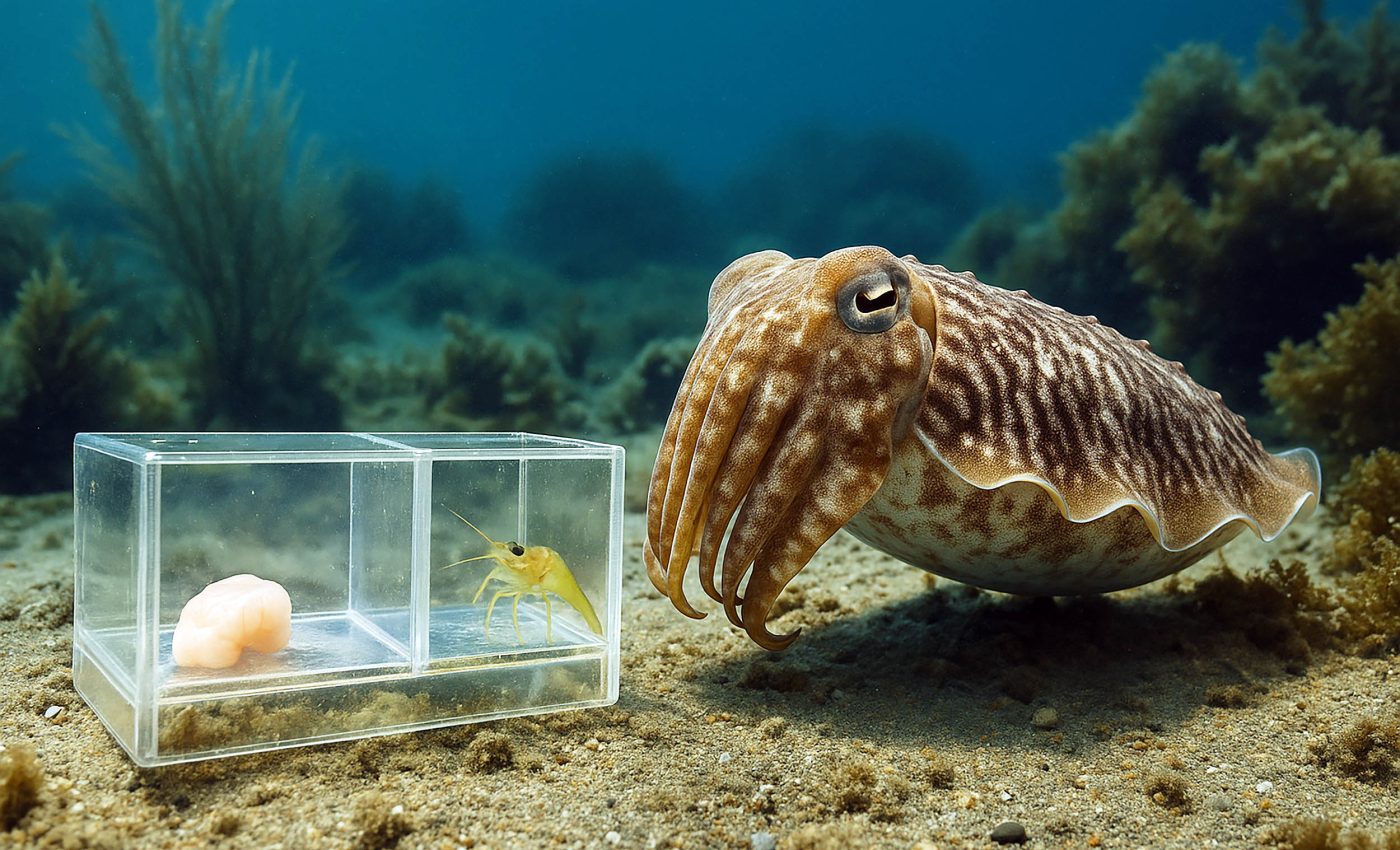
Cuttlefish easily passed a test designed for kids, startling scientists with their intelligence
Waiting is hard. Whether it’s a child eyeing a cookie or a sea creature hovering above a crab, the tug between “now” and “later” shapes daily choices. Across species, holding off for a better payoff often pairs with sharper thinking and long-term success.
Scientists have tracked this link for decades in humans and chimpanzees, yet evidence in animals without fur or feathers has been thin.
A new study puts cuttlefish at center stage with the famous “marshmallow test,” and shows that these soft-bodied hunters can summon patience – and brainpower – to rival some of the flashiest vertebrates.
Patience, marshmallows, and cuttlefish
Self-control is the mental brake that lets an individual pass up an immediate bite for a bigger meal down the road. In people, stronger self-control predicts better grades, steadier income, and healthier habits.
Among animals, apes, parrots, and crows often wait, while monkeys, rats, and pigeons seldom do. Biologists think the variation reflects how each species makes a living.
Lifespan, growth rate, and food supply all shape patience. Long-lived creatures can afford to wait, and social animals may hold back until a partner arrives.
Predators stalking elusive prey, from ravens to reef fish, also do well to bide their time. Untangling which factor matters most is tough because many well-studied vertebrates share several of those traits.
Undersea cuttlefish marshmallow test
The famous marshmallow test gave preschoolers one marshmallow right away or two if they waited 15 minutes.
To translate that setup underwater, the team offered hungry cuttlefish a piece of ordinary shrimp and, behind a clear barrier, a tastier live grass shrimp.
Sliding doors let each animal see both treats while controlling when each became reachable.
Some cuttlefish snatched the plain snack at once. Others hovered, watched, and resisted for more than two minutes, choosing the better catch when the moment came.
Individual wait times ranged from 50 to 130 seconds, figures that match those reported for parrots and crows despite the cephalopods’ far shorter lifespan.
How did they perform?
The work comes from lead author Alexandra Schnell of the University of Cambridge, who collaborated with Marine Biological Laboratory senior scientist Roger Hanlon and colleagues.
“We used an adapted version of the Stanford marshmallow test, where children were given a choice of taking an immediate reward (1 marshmallow) or waiting to earn a delayed but better reward (2 marshmallows),” Schnell explained.
The cuttlefish that participated in the marshmallow study were able to wait for the better reward, tolerating delays of up to 50–130 seconds.
This is comparable to what we see in large-brained vertebrates such as chimpanzees, crows, and parrots.
Patience alone would be interesting, yet the researchers also asked whether it linked to learning ability. They trained each animal to match a colored mark on the tank wall with food, then reversed the rule so the reward switched colors.
“The cuttlefish that were quickest at learning both of those associations were better at exerting self-control,” Schnell continued.
Patience pays off
Reversal learning tests mental flexibility because an animal must suppress a habit and update its plan when conditions flip.
In the study, individual cuttlefish that waited the longest in the marshmallow food test also adapted fastest when the color code changed.
The pairing hints that the brain circuits holding an impulsive tentacle in check may also help rewrite memories on the fly.
The findings appeared in Proceedings of the Royal Society B, marking the first documented link between delayed gratification and intelligence outside the primate lineage.
For researchers, that pushes complex cognition deeper into the tree of life and invites fresh questions about how such abilities evolve among invertebrates.
Why cuttlefish wait on the marshmallow
Cuttlefish spend most of their time camouflaging, sitting and waiting, punctuated by brief periods of foraging.
“They break camouflage when they forage, so they are exposed to every predator in the ocean that wants to eat them,” Schnell concluded.
“We speculate that delayed gratification may have evolved as a by-product of this, so the cuttlefish can optimize foraging by waiting to choose better-quality food.”
That scenario fits their daily routine. A cuttlefish can blend its skin with pebbles or coral in less than a second, then freeze for hours.
Every dash into open water risks a chase from cod, dolphins, or bigger cephalopods, so selecting the richest prey while exposed could boost energy intake without extra danger.
Finding intelligence everywhere we look
Octopuses and squids already headline stories for maze solving and coconut-shell shelter building, yet cuttlefish now join them as evidence that big brains are not the only route to sophisticated behavior.
Similar challenges – avoiding predators while hunting nimble prey – can mold very different nervous systems into comparable solutions through convergent evolution.
Self-control underpins planning, cooperation, and perhaps the roots of culture in vertebrates.
Finding the same thread in a creature that last shared an ancestor with humans more than 500 million years ago suggests that patience is more than a moral virtue; it is a versatile strategy etched deep into the fabric of life.
The full study was published in the journal Proceedings of the Royal Society B.
—–
Like what you read? Subscribe to our newsletter for engaging articles, exclusive content, and the latest updates.
Check us out on EarthSnap, a free app brought to you by Eric Ralls and Earth.com.
—–













